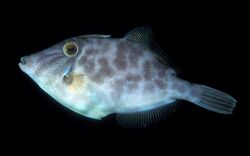Biology:Smooth leatherjacket
| Smooth leatherjacket | |
|---|---|

| |
| Scientific classification | |
| Domain: | Eukaryota |
| Kingdom: | Animalia |
| Phylum: | Chordata |
| Class: | Actinopterygii |
| Order: | Tetraodontiformes |
| Family: | Monacanthidae |
| Genus: | Meuschenia |
| Species: | M. scaber
|
| Binomial name | |
| Meuschenia scaber (J. R. Forster, 1801)
| |
The smooth leatherjacket or velvet leatherjacket, Meuschenia scaber, is a filefish of the family Monacanthidae, found off eastern Australia and all around New Zealand to depths of about 100 m, on rocky weedy reef areas. Its length is between 25 and 35 cm. In New Zealand it is simply known as leatherjacket as it is the only fish of this family commonly found there, by the Māori language name kōkiri, or by its commercial name cream fish.[1]
Distribution
The species is found from Cape Naturaliste, Western Australia, to Sydney, New South Wales, around Tasmania, and around the waters of New Zealand.[2]
Behaviour
Leatherjackets have a hard, sandpaper-like exterior which they use as a defense mechanism, which causes the fish to swim slowly. Because of this, the diet of leatherjackets is atypical, focusing on slow-moving species such as sponges, sea squirts and barnacles.[1]
Smooth leatherjackets are monogamous.[1]
In a human context
Leatherjackets developed a reputation for being bold among Māori in New Zealand, who named the fish kōkiri, a Polynesian word used to describe species such as triggerfish. The fish was one of the most commonly found in middens from the archaic period of Māori history. Yellowfish liver was known as a delicacy among Māori.[1]
The fish developed a poor reputation among early European fishermen in New Zealand, as the fish would often eat bait without being caught due to their small mouths. The fish were difficult to sell, with many fishmongers removing the heads and skin of fish. Over time, the name cream fish was adopted as a more palatable name for the fish, which boosted sales.[1]
See also
- Leather jack
References
- ↑ 1.0 1.1 1.2 1.3 1.4 , Wikidata Q114871191
- ↑ Edgar, Graham J. (2008). Australian Marine Life: The plants and animals of temperate waters (Second ed.). Sydney: New Holland. ISBN 9781921517174.
External links
- "Meuschenia scaber". Integrated Taxonomic Information System. https://www.itis.gov/servlet/SingleRpt/SingleRpt?search_topic=TSN&search_value=646154.
- Froese, Rainer and Pauly, Daniel, eds. (2006). "Meuschenia scaber" in FishBase. January 2006 version.
- Tony Ayling & Geoffrey Cox, Collins Guide to the Sea Fishes of New Zealand, (William Collins Publishers Ltd, Auckland, New Zealand 1982) ISBN:0-00-216987-8
Wikidata ☰ Q1901712 entry
 |



